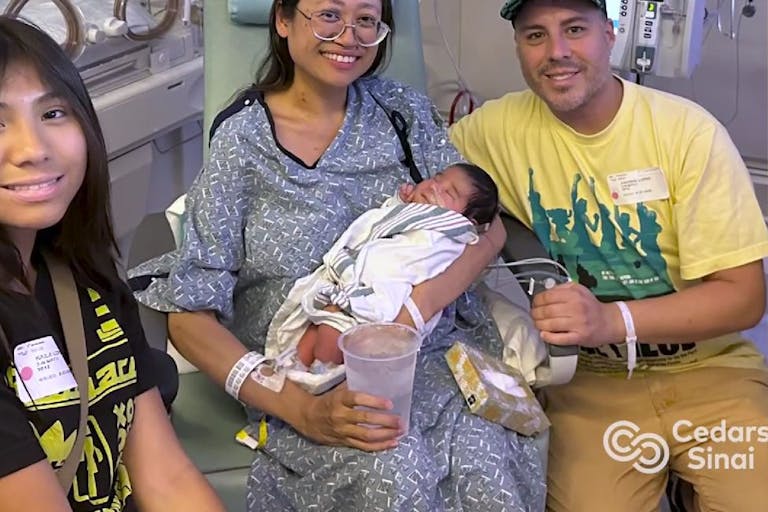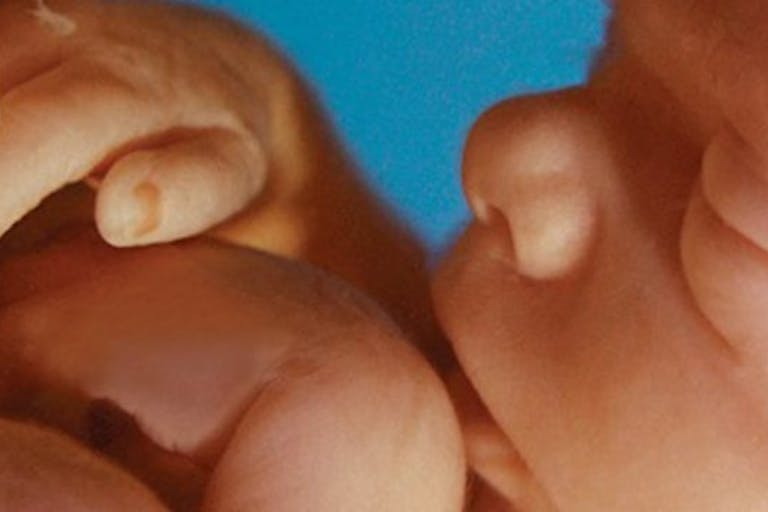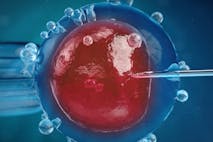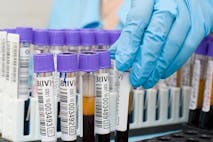
Full term 'miracle' baby born after 'unprecedented' ectopic pregnancy
Bridget Sielicki
·
Opinion·By Wendy J Broderick Smith, MSN, ACNP-retired
Is the question of when a preborn child feels pain the right question to ask?
In the abortion debate, fetal pain is controversial and complicated. When does the developing fetus actually feel or respond to pain? How do we know when actions are responsive rather than reflexive? How do we measure response: by movement/withdrawal from a noxious stimulant, or by measured endocrine/hormonal responses to stress?
Is it even possible to answer these questions definitively, since pain is subjective and has been described as “an emotional and psychological experience that requires conscious recognition of a noxious stimulus”?
Are these even the right questions to ask?
Short science lesson: The human brain is an extremely complex human organ. Neurons are the specialized cells that transmit nerve impulses. In order to pass the impulse from one neuron to another, neurons have dendrites which extend out from the cell body. Dendrites receive the impulse and carry it to the cell body. Neurons also have arms that extend out from the cell body called axons, which transmit the impulses away from the neurons to other neurons or tissues. They communicate with one another over junctions called synapses. It has been estimated that 86 billion neurons, along with innumerable synapses, dendrites, axons and support cells make up the human brain. These processes are far too complex to review in detail as volumes of journal articles and texts have been written in an attempt to describe the intricacies and complexities of the nervous system.
From the moment of fertilization, the genetic blueprint contained within the new human being’s DNA is set in motion and development proceeds rapidly. Evidence of human brain and spinal cord development have been noted as early as the third week after fertilization. The neural groove is first seen at approximately day 20-21 post-fertilization. Then by the sixth week, reflex responses to touch have been noted.1
According to a study published in the US National Library of Medicine, “In the first trimester, fetal movements grow rapidly in frequency and complexity. If around seven weeks of pregnancy only gross movements are visible; at the end of the first trimester the fetus presents complex movements of the head, limbs and fingers.” Much of the preborn child’s neuronal development occurs between 8 and 18 weeks.
According to a 2005 report in the Journal of the American Medical Association, “[…] tests of cortical function suggest that conscious perception of pain does not begin before the third trimester.” And in March 2010, the UK’s Royal College of Obstetricians and Gynecologists (RCOG) issued a report which concluded, “The lack of cortical connections before 24 weeks… implies that pain is not possible until after 24 weeks. Even after 24 weeks, there is continuing development and elaboration of intra-cortical networks.”
On the other hand, human fetal endocrine responses to stress have been demonstrated from as early as 18 weeks gestation. Though we have seen tremendous advances in neuroimaging (4D ultrasound, electroencephalography, magnetoencephalography, functional magnetic resonance imaging, etc.), most of the studies regarding fetal pain involve the second trimester. However, one recently published study suggests that preborn children may feel pain as early as the first trimester, because they have been found to have “‘adult-like’ patterns of nerves.” And, as Live Action News’ Rebecca Downs noted in 2015, other research has shown that pain experienced by the preborn child may actually be more intense than the pain experienced by a full-term child:
Article continues below
Dear Reader,
Have you ever wanted to share the miracle of human development with little ones? Live Action is proud to present the "Baby Olivia" board book, which presents the content of Live Action's "Baby Olivia" fetal development video in a fun, new format. It's perfect for helping little minds understand the complex and beautiful process of human development in the womb.
Receive our brand new Baby Olivia board book when you give a one-time gift of $30 or more (or begin a new monthly gift of $15 or more).
Preborn children also have an “early fetal response to painful stimuli,” researchers say. These can be detected roughly five weeks after fertilization. And, not only can preborn children feel pain, they may feel it more intensely. In 2004, Dr. Kanwalijeet “Sunny” Anand testified the following before Congress:
“Mechanisms that inhibit or moderate the experience of pain do not begin to develop until 32 to 34 weeks post-fertilization,” Anand said. “Any pain the unborn child experiences before these pain inhibitors are in place is likely more intense than the pain an older infant or adult experiences when subjected to similar types of injury.”
Based on a review of literature and evidence thus far, we can at least infer that the fetus may experience pain between 18-24 weeks gestation. Elective abortions are, of course, performed on preborn children at this gestational age, as noted by the Planned Parenthood abortionist featured in the most recent video from the Center for Medical Progress, who stated that her late-term abortions were mainly elective, and admitted she had to “hit the gym” to have enough upper body strength required to perform dismemberment abortions on babies at this stage of development. Watch former abortionist Dr. Anthony Levatino explain the process of a D&E dismemberment abortion in the video below:

Is the question of fetal pain really just a rabbit trail?
After all, brain development is a life-long process. The point is not so much whether the fetus feels pain, whether a newborn is aware of self, or whether a teenager can describe his emotions or even think rationally. The main point is that the fetus is a human. The stages of development of the neurologic system are part of normal human growth and development. This is a process that occurs in every human being from fertilization on into adulthood.
From fertilization, the DNA in that first cell orchestrates this innate process. The DNA is unique to the individual; it is each person’s own signature. It is this same DNA that guides differentiation from the first pluripotent stem cell into all of the complex, intricately interwoven and highly interdependent body systems.
DNA can be obtained from a cigarette butt at a crime scene and not only confirms that the criminal was human, but it can also identify the criminal by name through a DNA data base. It is the criminal’s own signature. Were a person to be killed in a massive explosion, tissue fragments would not only recognize that person as human, but would also identify his or her DNA signature by name, enabling the person’s next-of-kin to be notified. DNA can be obtained from saliva and sent off to be analyzed by a geneticist or genealogist and not only confirm the person’s life, but also trace the person’s ancestors going back generations.
And DNA obtained from fragments or fetal tissue can confirm humanity and parentage.
Only one question truly needs to be asked: “Is the fetus a human being?” If it is, then abortion is the taking of a human life. This is a simple question. Whether it is the first cell at fertilization, a morula, a blastocyst, an embryo, a fetus, or a full-term preborn child just inches and moments from birth – abortion at any moment is ending the process of normal human growth and development. With current technology, it is possible to capture images from fertilization to birth.8 The human genome has been mapped, opening our understanding to DNA.
And thanks to that understanding, we know that to deny the humanity of the preborn child is to deny science.
Moore, KL., Persuad, TVN., Tochia, MG. The Developing Human: Clinically Oriented Embryology, 10th Elsevier, Inc. 2016.
Live Action News is pro-life news and commentary from a pro-life perspective.
Contact editor@liveaction.org for questions, corrections, or if you are seeking permission to reprint any Live Action News content.
Guest Articles: To submit a guest article to Live Action News, email editor@liveaction.org with an attached Word document of 800-1000 words. Please also attach any photos relevant to your submission if applicable. If your submission is accepted for publication, you will be notified within three weeks. Guest articles are not compensated (see our Open License Agreement). Thank you for your interest in Live Action News!

Bridget Sielicki
·
Guest Column
Emily Berning
·
Opinion
Nancy Flanders
·
Opinion
Mark Wiltz
·
Opinion
Mark Wiltz
·
Pop Culture
Madison Evans
·
Guest Column
Wendy J Broderick Smith, MSN, ACNP-retired
·
Issues
Wendy J Broderick Smith, MSN, ACNP-retired
·
Media
Wendy J Broderick Smith, MSN, ACNP-retired
·
Human Rights
Wendy J Broderick Smith, MSN, ACNP-retired
·
Issues
Wendy J Broderick Smith, MSN, ACNP-retired
·